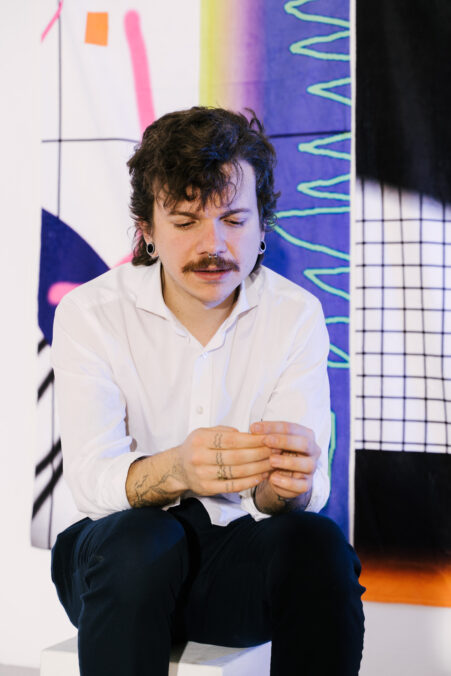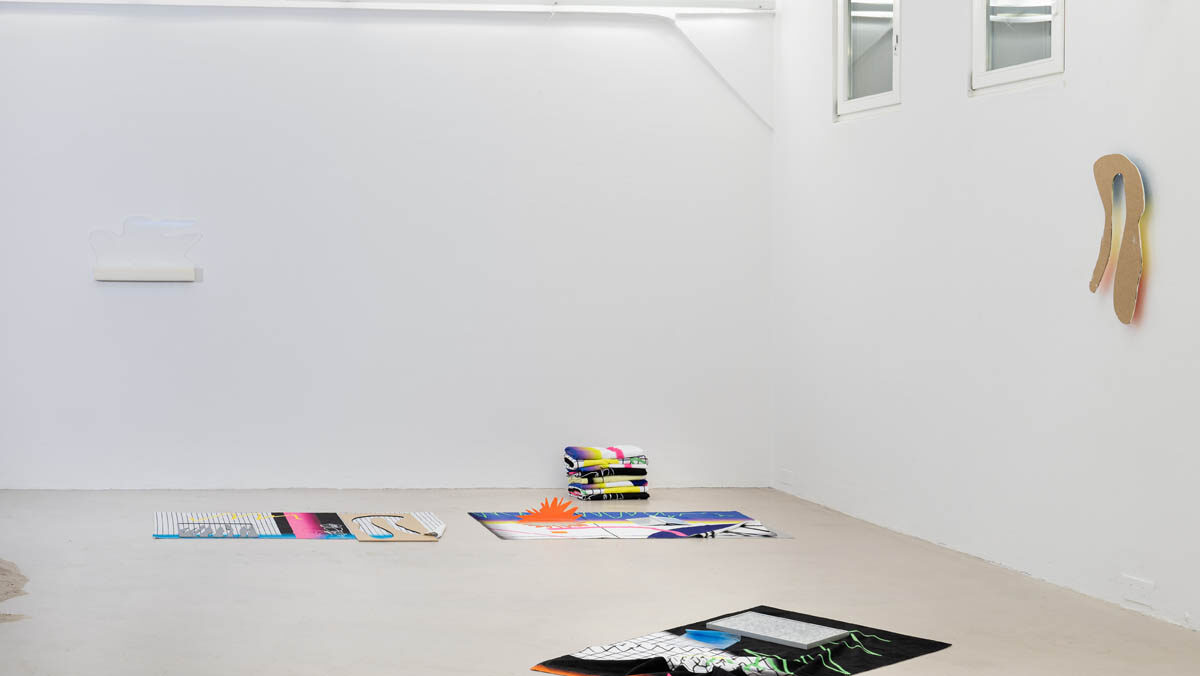
ESH: I would like to start the whole conversation maybe by focusing on the work Freundschaftsring. Such an interesting amalgamation of materials, themes: a wheel, perfectly sculpted horoscope signs on top of it, and the uncontrolled directions that the wheel can go. Can we start from here?
19.07.2023, Francisco Valença Vaz: Here is an answer to your question, which I am elaborating quite freely and irresponsibly here: I am not sure, but I think this work is kind of ironic. The car tire is like a monument that symbolizes the oldest way to move our bodies geographically, which is, for me, more or less an apparatus that provides migration. Over its surfaces, I have modelled the horoscope symbols, which I associate with movement, in their tradition to give direction to sailors in the sea. This way, I am combining two recognizable narratives: an environment-unfriendly wheel, like Fordism, together with an ancient way of reading directions. This object is animated, spinning in different directions, as a reference to the way planets and stars move around the earth. Migration is therefore an important association, related to narratives embedded into movement. Freundschaftsring also suggests not having a direction, rotating randomly. I appreciate this nihilism.
It means a plastic-tire is not giving me hope or a perspective for a greater future, and maybe the horoscope neither.
This work could be about projecting hope. As well it is composed resembling the aesthetics from advertisements and other visual elements related to capitalistic strategies. To finalize it, I am thinking about what could be a good introduction to come closer to my processes, and I think it is to remember the feeling of buying tomatoes and having them packed into plastic bags. You walk back home and slowly with your movements, all the tenderness of consumption starts to be wrapped into a sneaky micro-plastic layer. Persuasive, clean, invisible power. The object looks like a new and fresh product, almost asking to be consumed, believed and hoped.
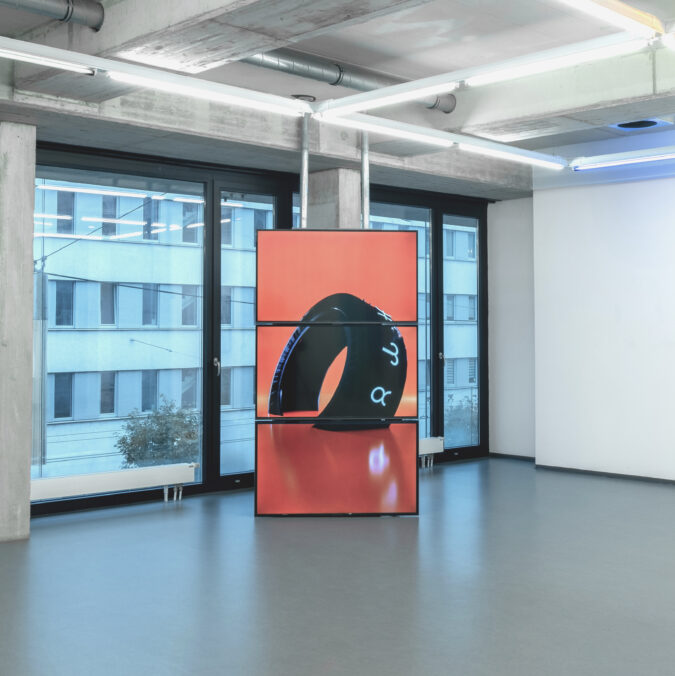
Created with GIMP
ESH: What is a place that brings you in writing modus, that could become the place of our correspondence?
13.08.2023, Francisco Valença Vaz: I am sitting on a train to visit the gallery in Salzburg and as I am approaching, it shortly made a lot of sense to text you. I wish to write to you in an honest way, in this sense, I won’t correct this that much, as well as I am optimistic that some thoughts can be more solidified here. Every time I am sitting on a train, I feel in movement and somehow interested in writing. In these situations, my thoughts are in movement, as well as my body. A similar feeling I share with train stations, airports and autobahns.
Maybe it is a feeling about passage or transition. It also reminds me of my works using materials related to migration and transport, like styrofoam used to transport goods, the car-tire itself, e-scooters, bikes and pizza boxes.
How do we tend to think that movement is mostly related to progress? From this question, we could start a critique of modernity and a necessary change in consumption economies. Therefore, coming back to Salzburg feels like a loop.
A street always goes in two directions and every cylinder has two sides.
And if there could be one point to start, I would be thinking about a form, related to projections and the persuasiveness of post-capitalistic surfaces, which reminds me about my learnings having Flaka Haliti as our teacher, and I could imagine her questions about form and affordance (strongly quoting her lessons here). It inspired me to understand my works differently and to think about them as a sort of relics. Ironically imagining if they could be found in the future. The latest works deal with connotations to Christianity, although the sculptures just look like shining, colorful and daily objects, almost suggesting that they could be freshly unpacked products. A sort of persuasive quality to invite you to think about what can be exactly behind them, things they could be hiding, which is usually just emptiness. Maybe emptiness as a form, supporting surfaces for alienation or opening space for conspiracy, and I question myself, how much of it can be found on synthetic plastic. Last year, when I was working in our studio at the Summer Academy, a group of journalists came in and were interested in some postcards lying on my table. The next day there was an article about this visit with my photograph and the postcards in my hand. It was funny, but also felt strange to come from a different place, break and re-create the local images related to identity, folklore and tourism, which relates to the title of my latest exhibition in Olomouc, “Who am I to trouble your happiness?” which is playful. Should I do it? Am I in the position to do it? It feels as if the artworks are self-claiming these titles, and I have difficulty reading them with my own voice. It consequently gives the works some indexicality and independence, as if they could question their own existence and transform themselves into something different. Like reading a book and change its meaning. And within these semiotics, reflections, I constructed a sculpture relating to a landscape, using a plastic cylinder and some postcards. I was enjoying to think about cultural landscapes as a surface for projections. Is the sky from Salzburg more pleasant than in other places, or the same I used to see as a kid in Brazil? Molding a construction, I do not know how much proximity I feel about being in Salzburg, but it doesn’t bother me. Maybe these feelings are about proximity and distance at the same time.
Souvenirs made of soap wish to be washed with water. Now I looked at myself using second-hand clothes and remembered my older work using newly printed polyester towels. A new shower towel does not represent identity related to a body but some opposition to it, it cleans the body, it dries it, like a “scanner” which you possibly use every morning.
A kind of daily performance, suggesting a narrative that keeps you remembering that you have a body to dry and to care for. Maybe showing precarity, a modern vanitas. Is this body something you can mould? These works with shower towels can be as intrusive as artificial as if these bodies could have been washed over time.
Before starting this series, I spent several years painting until I felt the need to transfer the same strategies to other mediums, also to separate my body from the work, as I used to have the common thought about painting as a register or prolongation from my own body, using some liquid over a surface. I decided to print the images I wanted to paint, reducing the movements of my arms to the movements of my mousepad. I could find other forms and think of this as an irregular text, agendas, produced forms of registration, labouring my machines to paint. The handwork was then reduced to background support. Yesterday, I had a funny thought: Maybe my research on manipulative aesthetics could bring me to enjoy these aesthetics even more, build awareness, or heal from something bad. It is a sort of consequence which I normally do not expect the work to have.
Like strangely feeling grief when a cinema closes.
From the beginning of my studies back in 2016, I have always tried not to repeat myself, and I know this is an interesting and common strategy for a lot of artists. I repeat a sort of thought process together with how I think generally, but I do try to refuse repetition when it is not needed for the work. It is quite hard not to do it. In the end, it isn’t a choice that contributes to a western tradition forcing the artists to be recognizable as brands, but it is a decision that brings me to a more interesting and flexible practice, also leading materiality to guide the next steps, and not willing to be fastly consumed. A good relationship that you stop. My newer works really looks like products of consumption, I do sometimes think these thoughts get mixed together. This path is more based on recasting some independence within an artistic production. Although for many artists‘ friends, time, repetition, and slower changes are vital to working something out of its materiality. Which is for me an intermediate step, some works are more self-referencial on their materiality, and others create singular narratives and illustrations, which aren´t in the materials to be found, being this a social-political critique like in “with persuasive trace resting having behind your shoulders” or in other works, a photograph depicting something that is not actually there.
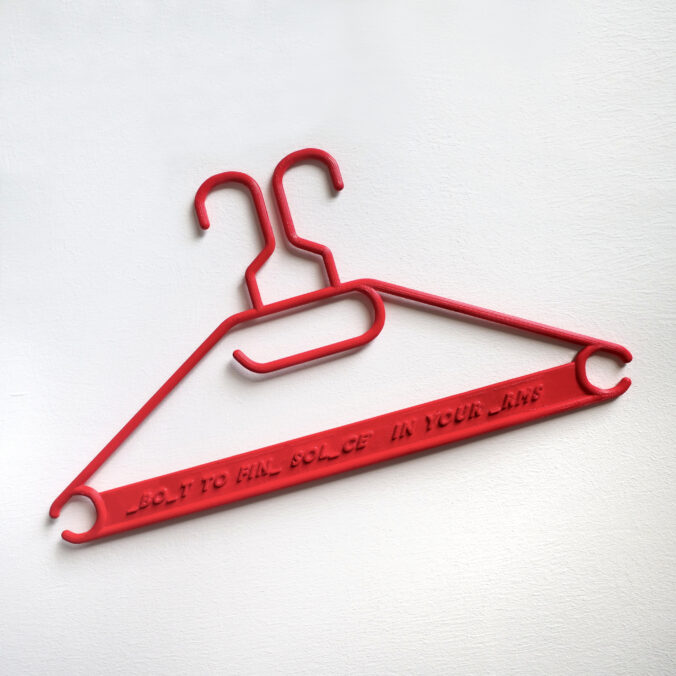
_BO_T, Francisco Valenca Vaz, 2023, Lack, Plastic.
ESH: You were on tour with Trauma Glow in Pordenone (Italy) recently. Maybe we could talk about music, we’ve never done that before. And I find it interesting that you are in transit again, and I imagine you stopping at gas stations with the band, drinking coffee, thinking about new works, letting go.
15.11.2023, Francisco Valença Vaz: The last weeks were full of different activities. We had our Trauma Glow concert in Pordenone and the exhibition in Salzburg was really fulfilling. Now I am again sitting in a train. Pordenone was for different reasons interesting. The Italian scene for our subgenre showed itself being completely DIY.
Chatting with people, I got to understand that our concert was organized just by three producers, who planned everything. It was in this sense interesting to see how a small group can start to manifest something like a “scenius” in Brian Eno´s terminology.
Pordenone has 50.000 inhabitants, and a lot of guests came to the venue by train or car from the other local cities around it. Some drove for two hours. As well as the week before, when we played in SUB Graz. A self-organized and non-profit space, with a beautiful ceramic ornament with the anti-fascist symbol. Talking with the organizers, I could come closer to understanding how much engagement is needed to establish a leftist center in the city. Now on the autobahn, driving back to Vienna after the concert, I worked on the last scenes for “every street has your name”. Dealing with references to Vanitas, the necessity of leaving something behind, and the relativism between materiality, body and consumer. I was again in movement while thinking about migration. The surfaces of the video were quite distant from the things of the real world, everything was more likely to be artificial.
I transformed monuments into models, and these loops, finding myself quoting documentations which in every turn of this car manifests itself slightly different.
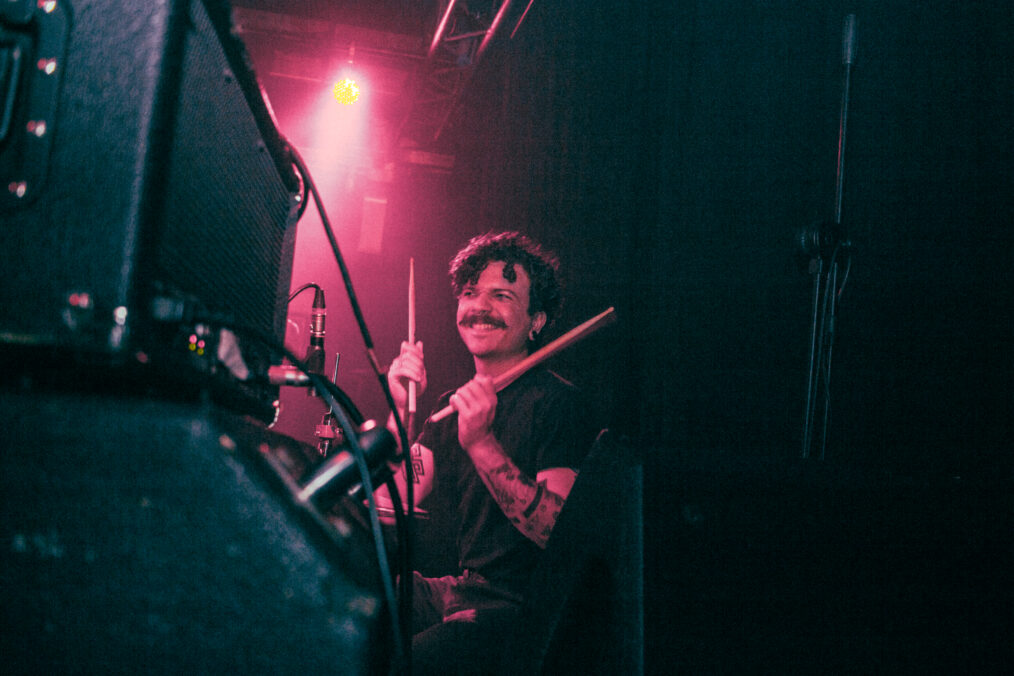
Astra, Pordenone, 2023, Photo: Davide Miniussi.
Excerpt by Grunge Rockers Band Trauma Glow, Editorial Choice: 30`
Trauma Glow’s debut single „30“ explores the profound journey of moving beyond the shackles of the past, yet it poignantly acknowledges that certain memories and images linger, etching themselves forever within the recesses of one’s mind. Through introspective lyrics, cathartic guitar riffs, and hauntingly emotive vocals, „30“ encapsulates the band’s ability to capture the bittersweet essence of human experience.
While seeing your work Bona fide, I started to think about vacations. How did this work emerged?
01.12.2023, Francisco Valença Vaz: Bona fide is a playful work and has something to do with genuinity. It comes back to when I started developing a process related to consumption and I got myself thinking a lot about popsicles. Along with the temperature difference, there is physical deception about them. When you eat something like that, and it is hot and summer, it melts in your mouth and becomes a boring gooey-sugary soup, which is a nice experience to reach using only a few artificial and cheap ingredients. On the other hand, “bona fide” popsicle is only made of wax. Like a praline that tastes completely different from the inside. A delicious-looking popsicle, normally consumed in tourist places, supporting a summer or vacation feeling. Coming back to your question, nowadays the idea we have about traveling, like a lot of things, is not what it used to be in the past, changing drastically after the second industrial revolution. At best, people normally want to go to the emptiest, most far away, exotic and warm places. And to move to these distant areas, we travel by cars, trains, aeroplanes and ships.
Therefore, when a ship burns its fuels, the rest of this process can produce a paraffin compound related to wax, which relates to “bona fide”. Would it be interesting to consume the rest of burned fuel from our physical migration and trade, and could this object be a monument for an artistic disappointment over wrong modern promises in the artworld?
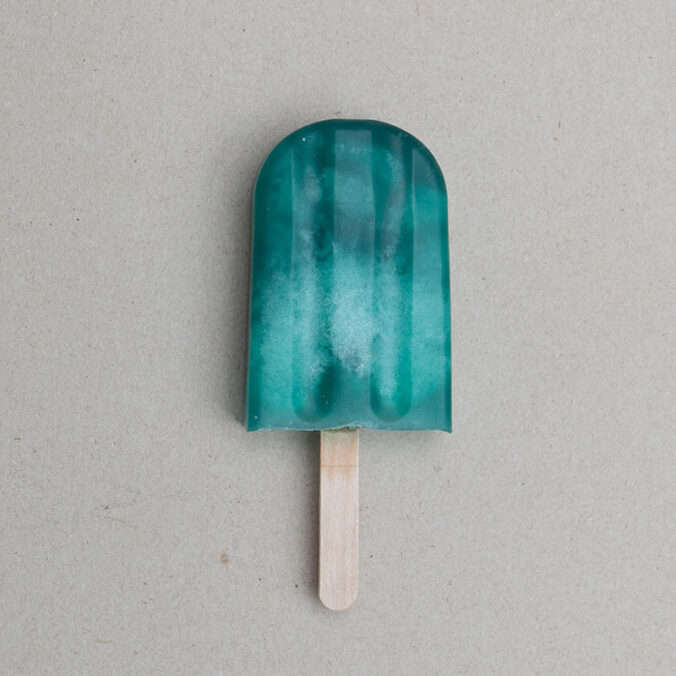
Bona Fide, 2022, Wax, Pigment. Photo: Gabriela Valdespino.
In the end I was surprised when I saw some structure on the wax surface of the object that looked like waves at the sea, frozen waves, not moving in any direction. At least “bona fide” means, as we expect, to be acting in good faith.
Note: From April 13th to May 18th, Francisco Valença Vaz’s work will be part of the upcoming Les Nouveaux Riches group exhibition at Kunstraum Pro Arte, Hallein. The exhibition brings together works by Alpine Gothic, Rebecca Merlic, Francisco Valença Vaz, and Mara Novak. Stay tuned!
Francisco Valenca Vaz – https://www.valencavaz.com, www.instagram.com/franciscovalencavaz
Post Scriptum: The coincidence that brought us into conversation was that at the time of our first meeting in a bar, I was finishing an interview with the artist Flaka Haliti, while Francisco happened to have recently been her student at the Salzburg Summer Academy. The following correspondence is a reflection, an attempt to find a special place to write and talk.
Francisco Valença Vaz (born 1996, Recife, Brazil) works with the means of painting to abolish it. He does not arrange color, surface and line on the canvas, rather he does it in space, with projection, shadow and light. He translates his immaterial, spatial images into small sculptures made of curved Plexiglas. In his more recent works, he uses flexible form objects that can be found in bathrooms all over the world: Towels and shower curtains. Graphic compositions are then printed onto these universally familiar yet poor materials. The resulting panel paintings change their shape as they are hung, folded and draped. Out of colored soap mass, the artist casts small objects which are more graphics than bodies. Out of transparent plexiglas he has laser cut amorphous shapes reminiscent of clouds, waves or boats. Their very cautious appearance manifests itself in a clear material whose outlines blur entirely due to light breaks and shadows. Francisco Valença Vaz lives and works in Vienna.
Erka Shalari (born 1988, Tirana, Albania) is an art writer and curator. She has been graduated in psychology and art management. Her work is dedicated to uncovering unique artistic positions in contemporary art. The work methodology is strongly influenced by psychology, epistemological works, and also affects and rituals. Since 2020, she has been working as an International Editor at Les Nouveaux Riches.




